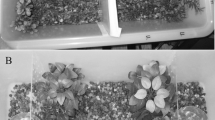Summary
In an experimental choice situation, individuals of both sexes of the lizard Anolis auratus choose to associate with a conspecific individual regardless of its sex. Further, individuals of both sexes associate with an individual of A. tropidogaster, a related species. Given the choice between the two species, they choose their own. Given the choice between a conspecific and a small patch of natural habitat, they do not choose one or the other consistently. These experiments indicate that conspecific association does not function just as a mate selection mechanism as has been previously proposed. The initial association may, in addition, serve a habitat selection function. Conspecifics can thus be seen as cues indicating the presence of suitable habitat as well as being important biological factors in themselves.
Similar content being viewed by others
References
Ballinger, R.E., Marion, K.R., Sexton, O.J.: Thermal ecology of the lizard, Anolis limifrons, with comparative notes on three additional Panamanian anoles. Ecology 51, 246–254 (1970)
Hunsaker, D.: Ethological isolating mechanisms in the Sceloporus torquatus group of lizards. Evolution 16, 62–74 (1962)
Jenssen, T.A.: Female response to filmed displays of Anolis nebulosus (Sauria, Iguanidae). Anim. Behav. 18, 640–647 (1970)
Kästle, W.: Zur Ethologie des Grasanolis (Norops auratus) (Daudin). Z. Tierpsychol. 20, 16–33 (1963)
Kiester, A.R.: Communication in amphibians and reptiles. In: How animals communicate. Sebeok, T.W. (ed.), pp. 519–544. Bloomington, IN: University of Indiana 1977
Kiester, A.R., Gorman, G.C., Colon, D.: Habitat selection behavior of three species of Anolis lizards. Ecology 56, 220–225 (1975)
Kiester, A.R., Slatkin, M.: A strategy of movement and resource utilization. Theor. Popul. Biol. 6, 1–20 (1974)
Pyburn, W.F.: Species discrimination in two sympatric lizards, Sceloporus olivaceous and S. pointsetti. Tex. J. Sci. 7, 312–315 (1955)
Rand, A.S., Williams, E.E.: The anoles of La Palma: Aspects of their ecological relationships. Breviora No. 327, 1–19 (1969)
Sexton, O.J., Heatwole, H.: An experimental investigation of habitat selection and water loss in some anoline lizards. Ecology 49, 762–767 (1968)
Siegel, S.: Nonparametric statistics. New York: McGraw-Hill 1956
Author information
Authors and Affiliations
Rights and permissions
About this article
Cite this article
Kiester, A.R. Conspecifics as cues: A mechanism for habitat selection in the Panamanian grass anole (Anolis auratus). Behav Ecol Sociobiol 5, 323–330 (1979). https://doi.org/10.1007/BF00292522
Received:
Issue Date:
DOI: https://doi.org/10.1007/BF00292522




